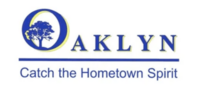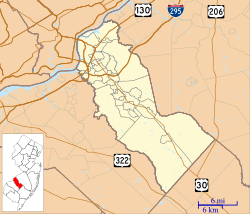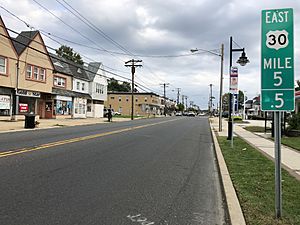Oaklyn, New Jersey facts for kids
Quick facts for kids
Oaklyn, New Jersey
|
||
|---|---|---|
|
Borough
|
||
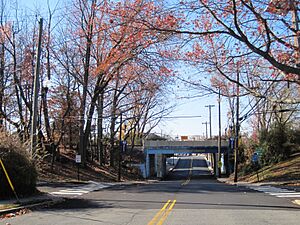
CR 649 (West Clinton Avenue) westbound in Oaklyn
|
||
|
||
| Motto(s):
Catch the Hometown Spirit
|
||
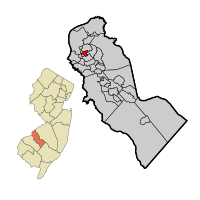
Oaklyn highlighted in Camden County
|
||
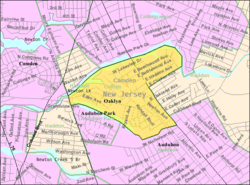
Census Bureau map of Oaklyn, New Jersey
|
||
| Country | ||
| State | ||
| County | Camden | |
| Settled | 1681 | |
| Incorporated | March 13, 1905 | |
| Government | ||
| • Type | Borough | |
| • Body | Borough Council | |
| Area | ||
| • Total | 0.70 sq mi (1.81 km2) | |
| • Land | 0.63 sq mi (1.62 km2) | |
| • Water | 0.07 sq mi (0.18 km2) 8.70% | |
| Area rank | 531st of 565 in state 30th of 37 in county |
|
| Elevation | 26 ft (8 m) | |
| Population
(2020)
|
||
| • Total | 3,930 | |
| • Estimate
(2023)
|
3,940 | |
| • Rank | 415th of 565 in state 26th of 37 in county |
|
| • Density | 6,265.7/sq mi (2,419.2/km2) | |
| • Density rank | 84th of 565 in state 6th of 37 in county |
|
| Time zone | UTC−05:00 (Eastern (EST)) | |
| • Summer (DST) | UTC−04:00 (Eastern (EDT)) | |
| ZIP Code |
08107
|
|
| Area code(s) | 856 | |
| FIPS code | 3400753880 | |
| GNIS feature ID | 0885331 | |
Oaklyn is a small town, called a borough, located in Camden County, New Jersey. It's a part of the U.S. state of New Jersey.
In 2020, about 3,930 people lived in Oaklyn. This number was a little less than in 2010. The town has a motto: "Catch the Hometown Spirit."
Contents
History of Oaklyn
Before Europeans arrived, the area where Oaklyn now stands was a thick forest. Lenape Native Americans lived here.
Early Settlements
In 1681, a group of Quakers came from Ireland. They were looking for a place where they could practice their religion freely. They sailed to Salem, New Jersey, and then up the Delaware River.
In 1682, they settled by Newton Creek. Their leader, William Bates, bought about 250 acres (1 square kilometer) of land from the local Native Americans. This first Quaker settlement was called Newton Colony. It was in the area that is now known as The Manor section of Oaklyn.
Growth and Development
The Newton Colony grew quickly. People cleared the land to start farms. Two important roads were built. One followed an old Native American path from the Delaware River to Egg Harbor. Today, this road is called the Black Horse Pike.
The other road was known as the Long-a-coming trail. It went from Atlantic City to Berlin, and then to Camden. This trail is now known as the White Horse Pike.
After the American Revolutionary War, some people from Virginia built a racetrack on the east side of the White Horse Pike. Even a future president, Ulysses S. Grant, visited this track when he was young. The racetrack closed in 1846.
Changing Names
Later, the farmland along Newton Creek was divided into smaller plots. This new development was called "Oakland the Beautiful" because of all the trees. But in 1894, the name was changed to Oaklyn. This was done to avoid confusion with another town named Oakland in North Jersey.
Oaklyn officially became a borough on March 13, 1905. It was formed from parts of Haddon Township.
Geography of Oaklyn
Oaklyn is a small town. It covers about 0.69 square miles (1.78 square kilometers). Most of this area is land, with a small part being water.
Oaklyn shares its borders with several other towns in Camden County. These include Audubon, Audubon Park, Camden, Collingswood, and Haddon Township.
Population and People
| Historical population | |||
|---|---|---|---|
| Census | Pop. | %± | |
| 1910 | 653 | — | |
| 1920 | 1,148 | 75.8% | |
| 1930 | 3,843 | 234.8% | |
| 1940 | 3,869 | 0.7% | |
| 1950 | 4,889 | 26.4% | |
| 1960 | 4,778 | −2.3% | |
| 1970 | 4,626 | −3.2% | |
| 1980 | 4,223 | −8.7% | |
| 1990 | 4,430 | 4.9% | |
| 2000 | 4,188 | −5.5% | |
| 2010 | 4,038 | −3.6% | |
| 2020 | 3,930 | −2.7% | |
| 2023 (est.) | 3,940 | −2.4% | |
| Population sources: 1910−2000 1910−1920 1910 1910−1930 1940–2000 2000 2010 2020 |
|||
2010 Census Information
In 2010, there were 4,038 people living in Oaklyn. These people lived in 1,725 households. About 1,007 of these were families.
Most of the people in Oaklyn were White (92.40%). There were also Black or African American (2.48%), Asian (1.81%), and Native American (0.22%) residents. Some people identified as being from other races or two or more races. About 5.37% of the population was Hispanic or Latino.
About 25% of households had children under 18. Many households (43.3%) were married couples living together. The average household had 2.34 people.
Looking at age groups, about 20.5% of the people were under 18. About 11.3% were 65 years old or older. The average age in Oaklyn was 39.4 years.
Education in Oaklyn
Oaklyn has its own school district called the Oaklyn Public School District. This district serves students from pre-kindergarten up to fifth grade. There is one school in the district. In the 2020-21 school year, there were 278 students and 28 teachers. This means there were about 9.9 students for every teacher.
Before the 2018-19 school year, Oaklyn Public School taught students up to ninth grade. It was the last district in New Jersey to have a Kindergarten through ninth grade setup.
Students from Oaklyn who are in sixth through twelfth grades go to schools in Collingswood. They attend Collingswood Middle School and Collingswood High School. This arrangement has been in place for over 40 years.
Transportation in Oaklyn
Oaklyn has about 11.92 miles (19.18 kilometers) of roads. Most of these roads are maintained by the borough itself. Some are maintained by Camden County, and a small part by the New Jersey Department of Transportation.
The main highway that goes through or near Oaklyn is U.S. Route 30. Other important roads nearby include a small part of New Jersey Route 168 and Interstate 76.
Public Transportation Options
NJ Transit offers bus services that connect Oaklyn to other towns.
- The 400 route goes between Sicklerville and Philadelphia.
- The 403 route connects Turnersville and Camden.
- The 450 route travels between Cherry Hill and Camden.
Notable People from Oaklyn
Many interesting people have lived in or are connected to Oaklyn:
- Mitch Albom (born 1958) is a famous author, journalist, and broadcaster.
- William Bates (died 1700) was the first English settler in the area.
- Andrew Clements (1949–2019) was a writer of children's books, known for his book Frindle.
- Tom Deery (born 1960) was inducted into the College Football Hall of Fame.
- Ralph W. E. Donges (1875–1974) was a Justice on the New Jersey Supreme Court.
- Matthew Quick (born 1974) is the author of The Silver Linings Playbook.
See also
 In Spanish: Oaklyn para niños
In Spanish: Oaklyn para niños


